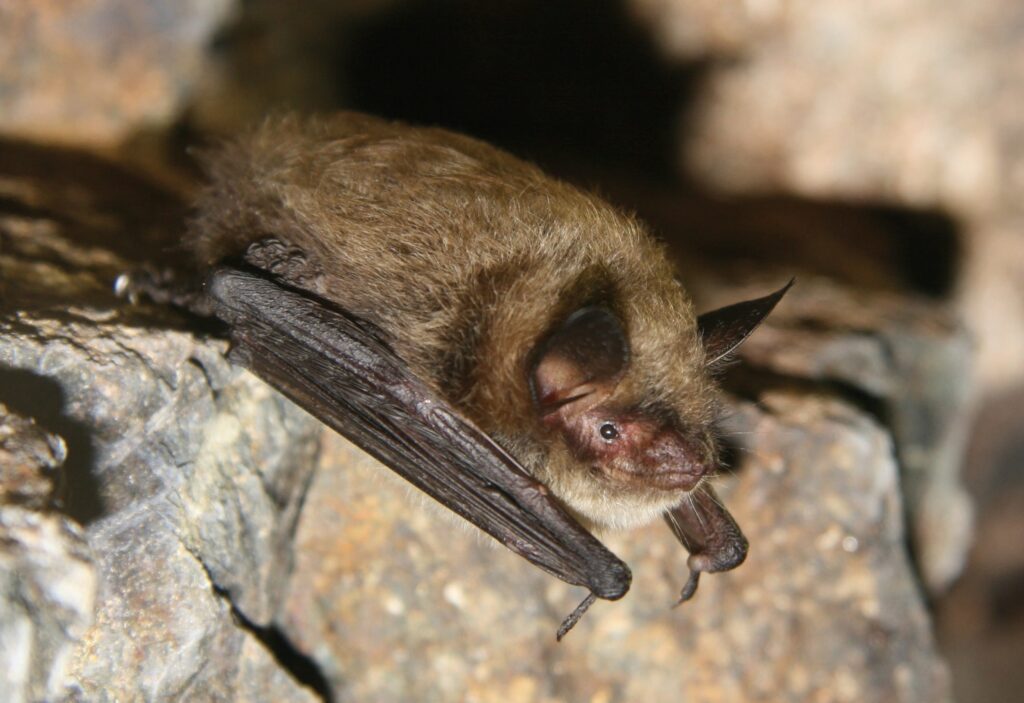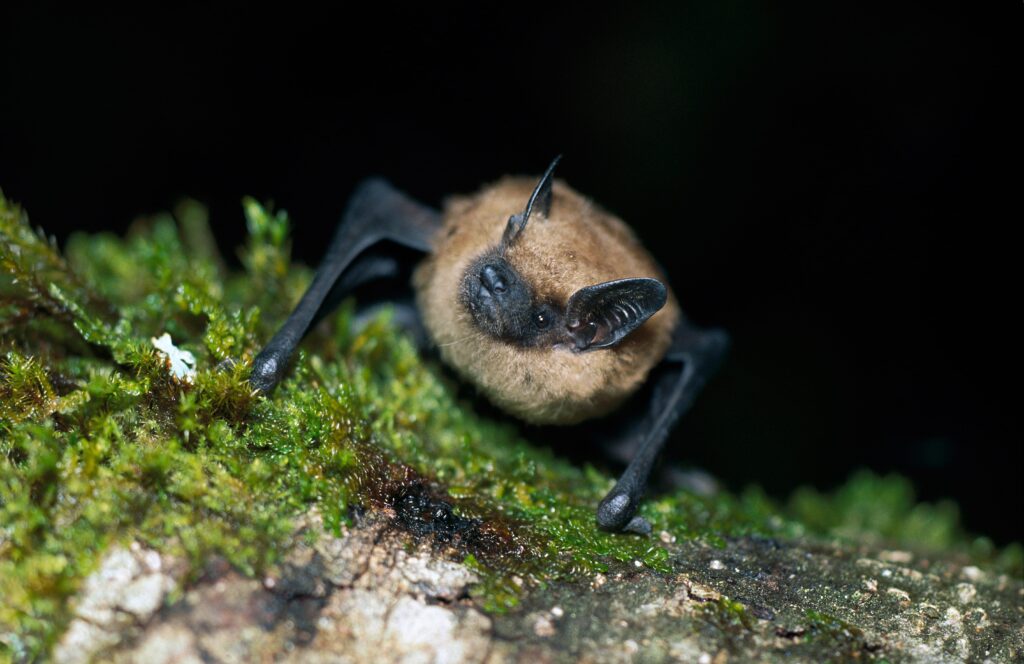As the weather gets warmer and more insects come out, you may start to see some of Minnesota’s native bat species! Part of the order Chiroptera (meaning hand-wing) bats are the only mammals capable of true-flight. Although they have been subject to some negative PR, bats are very helpful creatures that participate in pest control, pollination, and seed dispersal. Some studies have estimated that bats consume enough pests to save the US corn industry over $1 billion/year in crop damage- and even more worldwide! Unfortunately, there are a few factors that are threatening their survival. Human activity can disrupt their hibernation, many are killed because of their misunderstood reputations, and several species are being threatened by a fungal infection called White-Nose Syndrome.
Meet Some Local Bats!

Little Brown Bat (Myotis Lucifigus)– The little brown bat is just that- little and brown! Weighing only half an ounce, the little brown bat was once a common sight in Minnesota. Unfortunately, due to White-Nose Syndrome, the species is now endangered and some studies have estimated they will be extinct in the next 65 years. (Photo: Jason Corbett, https://www.batcon.org/bat/myotis-lucifugus/)
Big Brown Bat (Epitiscus fuscus)– Now the most common species encountered in Minnesota (and the most likely to be holed up in your attic over the winter), the big brown bat is almost double the size of the little brown bat- although still quite small, often weighing less than 1 ounce! This bat is not migratory and may hibernate in buildings where it can easily access foraging areas as the weather warms up! (Photo: Michael Durham, Minden Pictures; https://www.batcon.org/bat/eptesicus-fuscus/)


Eastern Red Bat (Lasiarus borealis)– This bat has a beautiful, bright red coat to help camouflage itself among dead leaves! They are a rare sighting and don’t associate with humans as much as other bats. You might happen upon them in California or Arizona, however, where they migrate over the winter! (Photo: J. Scott Altenbach; https://www.batcon.org/bat/lasiurus-borealis/)
Hoary Bat (Lasiarus Cinereus)– Named after their smoky grey color, the Hoary Bat migrates to tropical areas in the wintertime. Their yellow face and frosted tips make them adorable little creatures! (Photo: Michael Durham, Minden Pictures; https://www.batcon.org/bat/lasiurus-cinereus/)


Silver-Haired Bat (Lasionycteris noctivagens)– Not to be confused with the Hoary bat, the silver-haired bat’s fur is darker at the base and in the face. This bat species are known to migrate and hibernate in the winter, leaving Minnesota to milder climates before entering their dormancy. (Photo: Michael Durham, Minden Pictures; https://www.batcon.org/bat/lasionycteris-noctivagans/)
How can I help bats?
- When bats are hibernating, it is important that they are not disturbed- waking up during their long slumber takes a lot of vital energy reserves that they need to survive! So if you happen upon some slumbering bats, try to leave them alone. It’s also important to report any sick or dying bats that you come across to the MN DNR in order to keep track of their status.
- Sometimes, bats find their home for the winter in houses or attics. Although it may be inconvenient to have these intruders in your space, the best way to remove them is not to kill them, but rather wait for them to leave and make sure all entry points are closed off. Killing any bats won’t stop more from coming in so the only way to permanently remove them is to make sure any holes or entrances are completely blocked. The timing is also a major factor in their removal as to not exclude female bats when they have babies, so be sure to consult with reliable literature!
- One of the biggest contributors to bat mortality is White-Nose Syndrome (WNS)- a fungal infection that has killed millions of bats since its introduction to the U.S. in 2006. In fact, the now endangered little-brown bat was once the most encountered by humans before its populations were decimated by WNS. Including the little brown bat, it is estimated that among 3 of the MN species affected by WNS, 90% have died from this infection since its introduction. In order to help stop the spread of WNS, it is important to honor cave closures and clean any equipment you bring into caves before using them again.
Sources
Barlow, Rich. “Countdown to Extinction for Little Brown Bat | BU Today.” Boston University, www.bu.edu/articles/2010/countdown-to-extinction-for-little-brown-bat/.
“Bats.” Minnesota Department of Natural Resources, www.dnr.state.mn.us/mammals/bats.html.
Celley, Courtney. “Bats Are One of the Most Important Misunderstood Animals | U.S. Fish & Wildlife Service.” FWS.gov, 11 June 2021, www.fws.gov/story/bats-are-one-most-important-misunderstood-animals#:~:text=Bats%20play%20an%20essential%20role.
Cheng, Tina L., et al. “The Scope and Severity of White‐Nose Syndrome on Hibernating Bats in North America.” Conservation Biology, vol. 35, no. 5, 20 Apr. 2021, pp. 1586–1597, https://doi.org/10.1111/cobi.13739. Accessed 29 Oct. 2021.
“Little Brown Bat | National Wildlife Federation.” National Wildlife Federation, 2019, www.nwf.org/Educational-Resources/Wildlife-Guide/Mammals/Bats/Little-Brown-Bat.
